Highlight: “Saunders emphasized the importance of having the work from her project funded and supported by the National Science Foundation and state agencies, highlighting the great value of investing in research like hers and resources like the ADC”
Background and Research Expertise
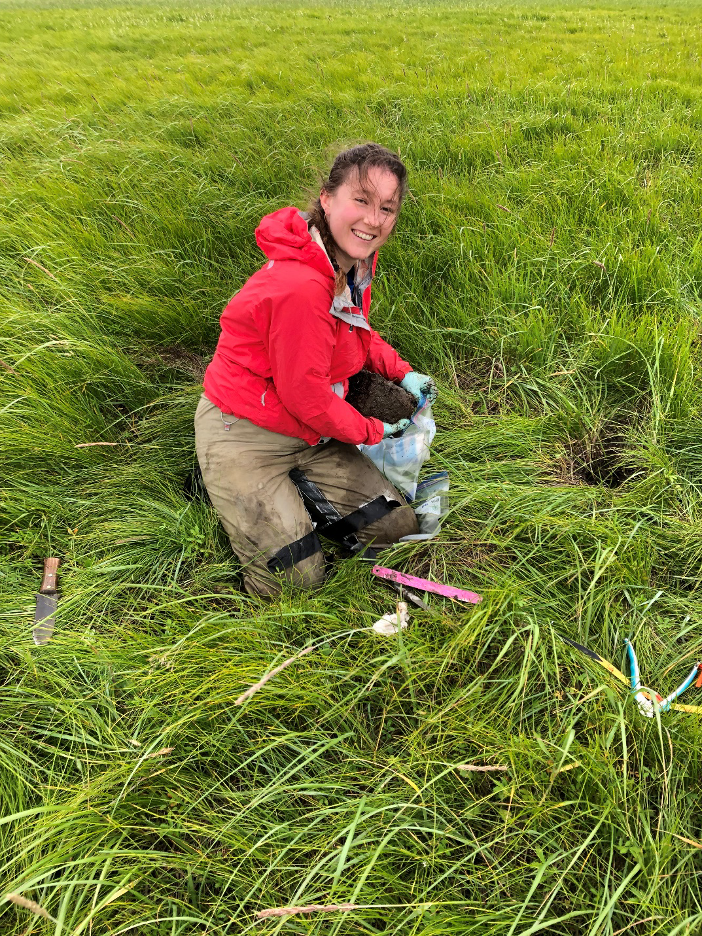
Taylor Saunders collecting soil samples in the Yukon-Kuskokwim River Delta in 2021. Photo credit: Dr. Karen Beard.
Prior to the Arctic, Taylor Saunders spent a few years immersed in the tropical climates of Puerto Rico and Hawai’i, conducting field work on a wide range of research objectives. These field experiences prepared her for a transition into working in Alaska, where she got the opportunity to build upon the skills she had learned and pursue a Master’s of Science in Ecology. Saunders noted the unique opportunity to learn in remote Arctic settings was parallel to the environmental challenges seen in the tropics, particularly with natural disasters and climate change. She currently serves as a field crew leader in the Department of Biology at the University of Nevada, Reno. During the summertime, she works with undergraduate students teaching them about local vegetation and conducting field surveys. This work is different to what she did in Alaska, but she loves that it keeps her involved in research.
The driving motivator behind this research was the lack of existing information on litter decomposition in the Yukon-Kuskokwim River Delta in Western Alaska. Saunders and her team recognized that studying how local geese populations affect soil features and vegetation structures could help better understand how carbon cycling in this region might change over time. These connections became clearer when comparing previous published studies of ungrazed and grazed areas, which showed where you could find more vegetation.
Dataset Highlight
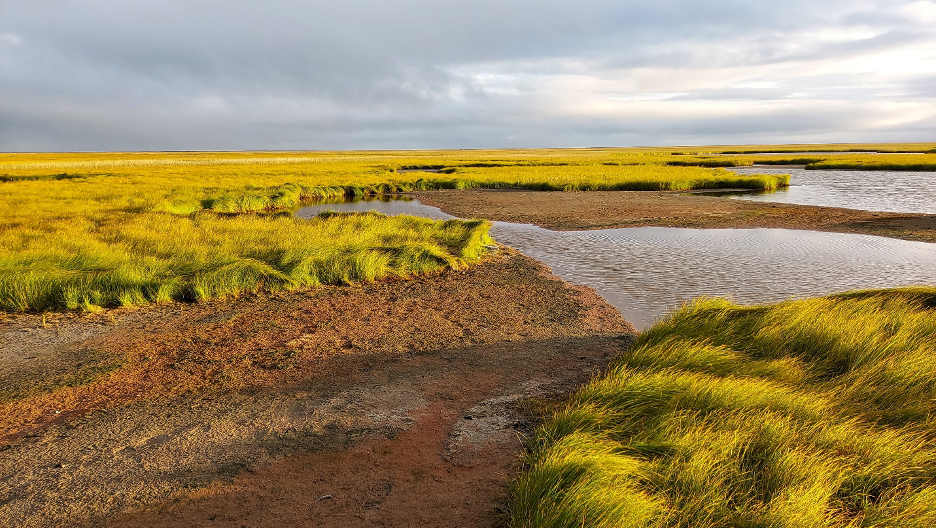
The field site has ponds across the landscape, providing optimal foraging sites for migratory waterbirds. Photo credit: Taylor Saunders.
This collaborative research involved a litter bag study where two litter types representing grazed (high quality) and ungrazed (lower quality) vegetation, were incubated in a ‘grazing lawn’ and ungrazed meadows. Measurements included litter mass loss, carbon, nitrogen, cellulose, and lignin content after 3, 6, 9, and 52 weeks, as well as abiotic conditions including soil temperature, UV radiation, throughfall, and soil moisture content in each habitat. Results showed that herbivore-induced increases in litter quality results in increased decomposition rates, while the accumulation of low-quality litter in ungrazed habitats is partly due to slow decomposition rates.
As part of this research effort, Saunders and colleagues published a dataset hosted by the Arctic Data Center:
- Trisha Atwood, Karen Beard, Bonnie Waring, Jaron Adkins, & Taylor Saunders. (2024). Tracing herbivore effects on litter decomposition in the Yukon-Kuskokwim River Delta 06/17/2022 – 06/16/2023. Arctic Data Center. doi:10.18739/A2H41JP43.
And a related paper was published in Plant Soil:
- Taylor Saunders, Jaron Adkins, Trisha B. Atwood, Bonnie G. Waring, & Karen H. Beard. (2025). Goose herbivory effects on early-stage litter decomposition in coastal Alaskan wetlands. Plant Soil (2025). doi:10.1007/s11104-025-07383-w
The Tools and Techniques Behind the Research
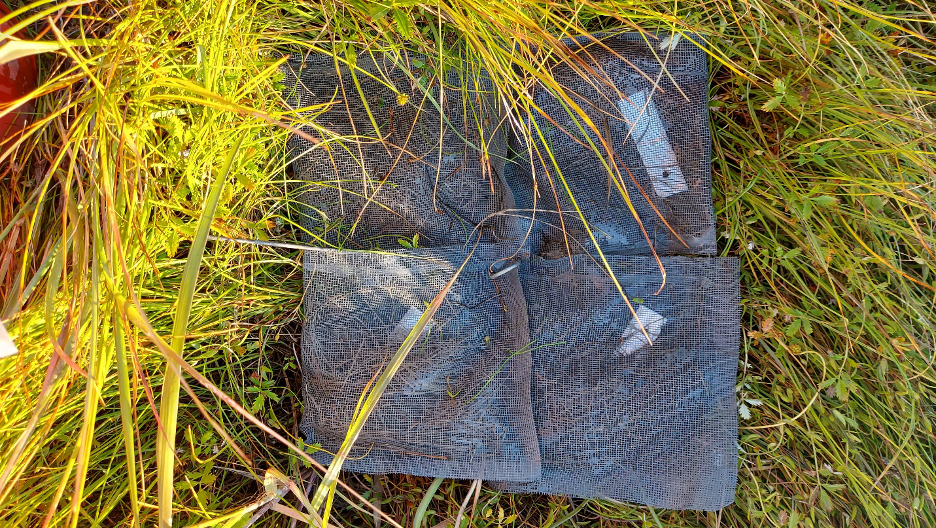
Four litter bags filled with senesced litter and placed in Carex meadow habitat at the beginning of the study. Photo credit: Taylor Saunders.
The main technology used in this research were litter bags made out of window screen materials as they would not decompose when in contact. As mentioned, these litter bags were filled with either grazed or ungrazed vegetation and they were left at the two sites for varying periods of time. Once collected, these samples were sent to various labs to be measured for mass differences and analyze how different abiotic conditions influenced decomposition. These measurements helped their team to determine how local geese populations might contribute to changes in soil characteristics and vegetation structure.
When asked about what technological innovations could advance Arctic research, Saunders emphasized the importance of remote sensing. Many areas in the Arctic aren’t easily accessible year-round and seasonal changes limit accessibility. Specifically, Saunders said, “[During the winter when snowfall is heavy] we couldn’t leave our temperature measuring tools out because they would get stuck in the snow.” With more advanced remote sensing technology, projects like hers could be more successful in gathering critical data under harsh, inaccessible conditions.
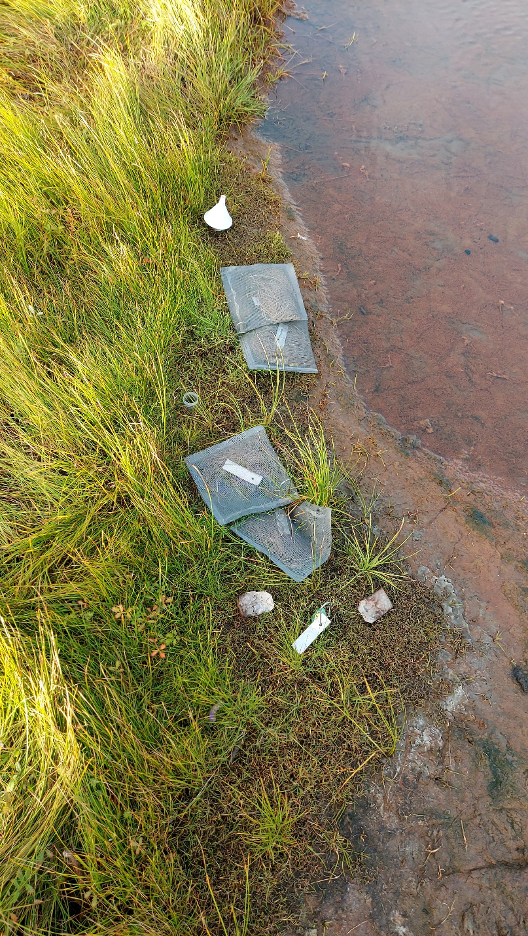
Litter bags placed in grazing lawn habitat. Photo credit: Taylor Saunders.
Working in the Arctic
While working in remote locations is exciting, the preparation it takes for a successful field season can be daunting. Saunders stated that “once you’re up there, you’re there for the whole season” and went on to explain how you must bring everything you need for months at a time with you when departing for the field. She mentioned that something unexpected always happens in the field, leaving researchers to get creative in dealing with issues using whatever resources they have on hand. One unexpected event that affected Saunders’ team was a flood that occurred shortly after their first field season (September 2022). Saunders explained how thankful they were that their litter bags survived the flood and reflected on the devastation this event caused to surrounding communities.
Inspiring the Future of Arctic Science
Saunders expressed great concern for ecosystems and communities that will be increasingly impacted by a quickly warming climate, which led into our discussion regarding the future of Arctic research. When asked what advice she would give to students or early career scientists interested in pursuing a career in Arctic research, Saunders explained that most established people in the field are willing and open to share resources and research ideas with the future generation of researchers. She emphasized that although reaching out to senior scientists can seem intimidating, it’s the best way to get your foot in the door. She went on to say that “everyone that’s already in a career position that you’re interested in has been in your shoes before and most people will likely remember how being early in their career felt and would be happy to help out”. For field research opportunities, Saunders recommended looking on ECOLOG-L (hosted by the ESA) or reaching out to researchers investigating research questions you are interested in.
Finding Fulfillment in People and Places
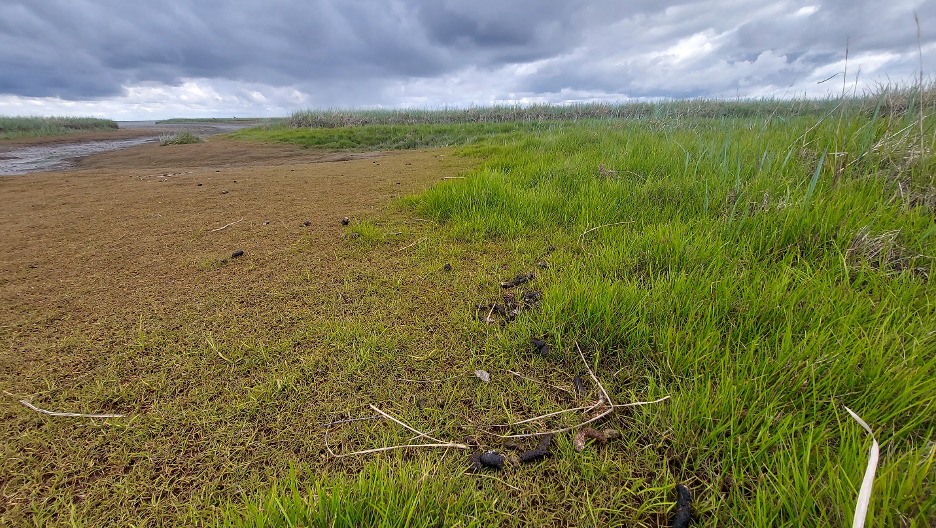
Geese produce “grazing lawns”: areas of short-statured, highly nutritious Carex, seen on the left. Photo credit: Taylor Saunders.
Saunders’ love for her colleagues and the outdoors is obvious. When asked about the most rewarding aspect of her career so far, she immediately responded with “being able to work with so many different people. I’m really lucky to have moved around and seen a lot of amazing places”. Saunders described her fieldwork experience as “immersive”, allowing her to fully engulf herself in the environment she’s studying. She noted that studying in the Yukon-Kuskokwim River Delta and the tropics are more similar than one might think due to their high rates of precipitation, but she finds the tropics more familiar after growing up in sunny California.
How the Arctic Data Center Empowers Researchers
 The data curation team at the Arctic Data Center (ADC) has been instrumental in Saunders’ team’s ability to move forward with publishing their datasets. While her research group has published a few other datasets in the past, she noted it was valuable to see what other great studies were completed in the area they were working in, made easy by the ADC’s map feature. Saunders emphasized the importance of having the work from her project funded and supported by the National Science Foundation and state agencies, highlighting the great value of investing in research like hers and resources like the ADC.
The data curation team at the Arctic Data Center (ADC) has been instrumental in Saunders’ team’s ability to move forward with publishing their datasets. While her research group has published a few other datasets in the past, she noted it was valuable to see what other great studies were completed in the area they were working in, made easy by the ADC’s map feature. Saunders emphasized the importance of having the work from her project funded and supported by the National Science Foundation and state agencies, highlighting the great value of investing in research like hers and resources like the ADC.
Co-written by Nicole Greco & Angie Garcia
Community Engagement and Outreach Coordinators, Arctic Data Center
